|
Secretaris-Generaal VN
Geregistreerd: 18 mei 2005
Locatie: Limburg
Berichten: 50.240
|

Citaat:
Oorspronkelijk geplaatst door gertc

Dus eerst zeg je dat ik fout ben, en vervolgens bevestig je dat in je eigen link hetzelfde staat...
|
Eigenlijk weet ik het niet juist, aangezien men niet weet wat een grote parking is. In elk geval dacht jij toch dat het om snelladers ging? Dus daar ben je fout indien je dat dacht.
Het gaat hoofdzakelijk enkel om level 2 chargers dat is laagspanning (240 Vac en 400 Vac). Een level 2 laadpaal staat in een figuur bijgevoegd 3.3 tot 6.6 kw, dus maal xx parkplaatsen laat zich het vermogen uitrekenen.
Ik denk dat voor de "grote parkings" het laagspanningsnet voldoende is.
Maar voor de "heel grote parkings" er toch een middenspanningshuisje in de directe buurt moet staan, zoals in elk klein dorp. 
Als je scrolt in de link kun je het lezen dat het stroomnet verbeterd moet worden, maar dat valt verassend heel goed mee, en dat de huishoudens ca 33% meer aan stroom gaan verbruiken zonder andere stroombesparing. Veel is dat niet, want er gaat ook bespaard worden op andere stroomverbruikers. De spaargrafiek per hoofd staat er ook bij.
Directe link:
Citaat:
https://ilsr.org/report-electric-vehicles/#grid
Impact: Improving the Grid
Electric vehicles boost demand for electricity.
On one hand, that’s great news for utilities. The average electric-powered car driver covers 12,000 miles annually, and one study calculated that the additional 4,000 kilowatt-hours used by an electric vehicle would increase a typical household’s yearly energy need by 33 percent (without adoption of energy efficiency measures). In small numbers, electric cars will change little, but in large numbers they could reverse the stagnant growth in electricity use, which has dropped in five of the last eight years and affected the bottom line of many electric utilities.
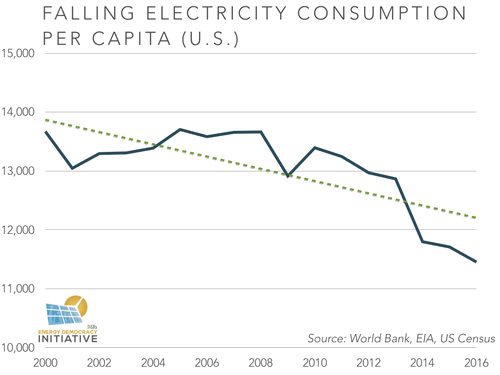
On the other hand, could this increased demand also increase the cost of operating the electric grid (and costs for electric customers) by shortening the life of grid components, requiring replacement or upgraded infrastructure such as transformers and capacitors, or even building new fossil fuel power plants?
Fortunately, the evidence suggests that electric vehicle expansion will reward, not ruin, the grid and its customers.
A rigorous analysis spearheaded by the California Public Utilities Commission in 2016 found substantial net benefits in electric vehicle adoption for the state’s electric grid and customers: worth $3.1 billion by 2030, even without smart charging policies and with vehicle adoption clustering in particular areas of the grid. This included the benefits of capturing federal tax credits, gasoline savings, and carbon credits in California’s greenhouse gas allowance transportation market plus all of the associated costs to the customer and grid.
The study also found surprisingly low costs for upgrading the local distribution grid. Even with a much higher vehicle adoption assumption of 7 million cars by 2030 (one-quarter of all registered vehicles), annual distribution infrastructure costs would be just 1% of the annual utility distribution budget.
A set of studies for northeastern states found a similar net benefit, even without smart charging policies, for vehicle owners, utilities, and society.
Relatively simple policy changes can enhance the payoff of adding thousands or millions of electric vehicles to the grid. California’s study suggests that the most potent and simplest tool to smoothly integrate electric vehicles is controlling when they charge. This can be done with special rates that give customers a discount for charging at grid-friendly times, or even using special chargers that disallow charging when grid demand is at its highest. These tools increase the efficiency of the electricity system, but also mean lower-cost fuel for electric vehicle owners, a win-win.
In an exhaustive analysis using time-of-use (TOU) pricing to strongly incentivize nighttime charging, the California Public Utilities Commission found that shifting from flat-rate to time-of-use charging increased net benefits from $3,600 to $5,000 per vehicle through significant reductions in the energy and infrastructure costs of charging.
While the California calculation includes the federal tax credit, the benefits are expected to persist even when that incentive expires because of falling electric vehicle and battery costs.
This following sections explore pricing tools that allow utilities and regulators to better manage grid supply and demand, rather than building new power infrastructure that could be obsolete early in its decades-long life.
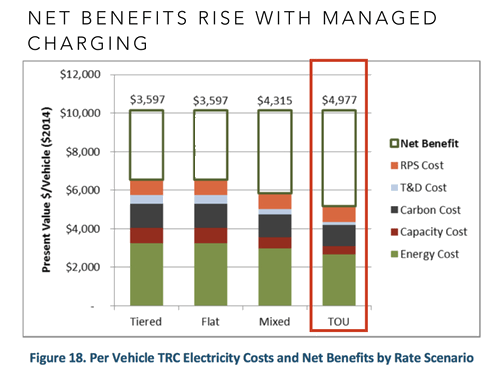
EV Charging Terminology
A quick note on charging before we dive in. Electric vehicles can be charged at different speeds by using different voltages. A standard 120-volt outlet can deliver about 1.3 kilowatts per hour but may take 12 or more hours to fully charge a vehicle. A 240-volt circuit can deliver a substantially faster charge and can be wired in a typical home or business. Direct current (DC) fast charging uses 440-volt charging that can “refuel” an electric vehicle battery in less than an hour. The following graphic from FleetCarma illustrates.
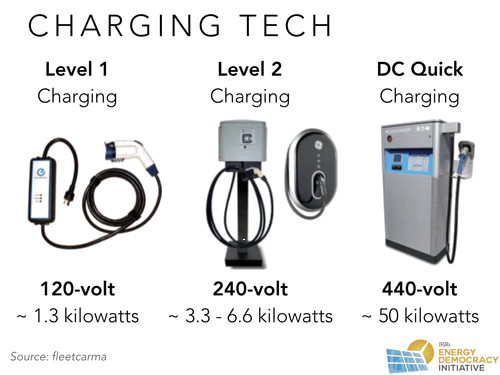
Managing Demand
With proper price incentives, grid managers can motivate electric vehicle users to avoid charging during periods of peak demand, to instead charge when demand is otherwise low, and to help smooth out large increases or decreases in demand.
The electric grid is designed around periods of peak energy use, with requirements for significant energy reserves dictated by the single-most congested hour of the year. By raising electricity prices at times of peak energy use (and reducing them elsewhere), utilities can largely minimize electric cars’ contribution to peak energy demand. Recent modeling by the Rocky Mountain Institute suggests optimized charging rates would limit Minnesota’s peak demand increase, for example, to just 0.5 percent when electric vehicles hit 23 percent penetration, compared with an increase of more than 3 percent without charging controls.
Minnesota wasn’t alone. In the four other states modeled, the Rocky Mountain Institute found peak demand impacts of widespread electric vehicle adoption could be significantly reduced with controlled charging. The following graphic illustrates.
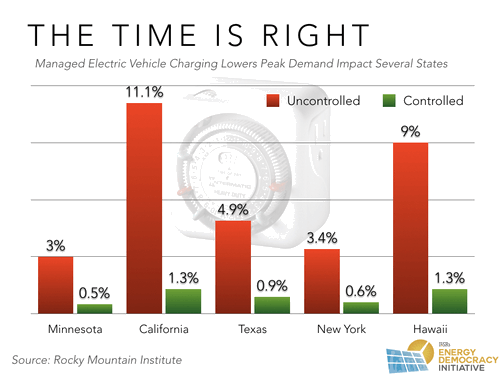
Utilities can also leverage electric vehicles to manage rapid changes in electricity demand. Historically, these ramps up or down have been driven by a morning surge in demand as people wake up and turn on lights and appliances, and another in the evening when stores remain open and residents return home. In some cases, these ramps are also influenced by rooftop solar generation, which sharply reduces demand from solar-powered neighborhoods in the daytime but spurs a sharp increase in local demand in the evening when residential demand increases as the sun sets.
Utilities typically prepare for these surges by activating gas power plants that can be put on standby or ramped up quickly. However, because these plants are relatively under-utilized, the electricity provided at peak periods is expensive. An August heat wave in Texas, for example, sent hourly electricity prices on the grid well over $1 per kilowatt hour on several occasions, more than ten times the usual price.
Utility wonks illustrate this challenge with the “duck curve,” shown below for the California Independent System Operator (CAISO). The issue is the steep curve starting around 4 p.m. and peaking around 8 p.m., driven largely by adoption of rooftop solar that drives down daytime electricity demand. One caveat: the deep dip is sometimes called “overgeneration” — implying that there’s too much solar energy production — an issue enhanced when the bottom axis reflects a minimum of 14,000 megawatts. One German observer notes that this issue (as opposed to the ramp) is exaggerated. For context, the chart is also shown with a zero axis.
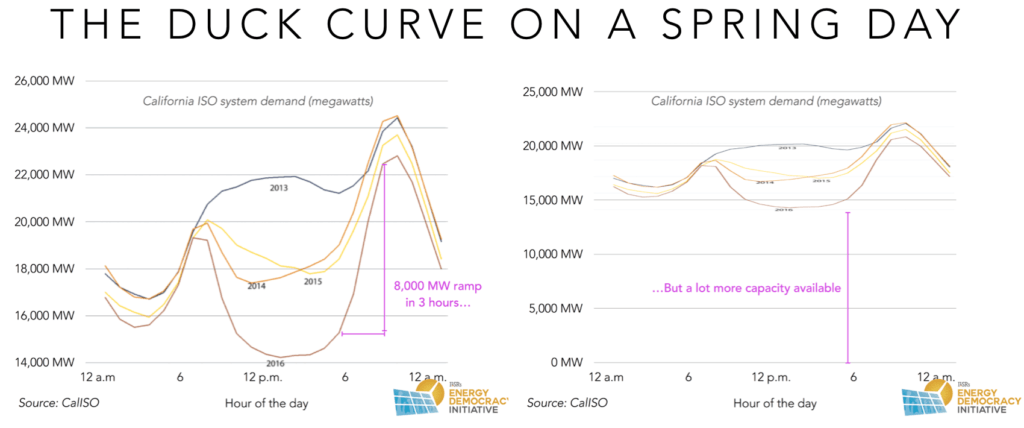
Although there are many potential solutions (the linked report from the Regulatory Assistance Project is particularly thorough), electric vehicles can help smooth the curve. By drawing power from the grid during the midday hours when solar output is greatest, electric vehicles can soak up the sun-generated power and in turn reduce the evening ramp-up. Fortunately, data from California suggests that 40% of electric vehicles remain at home even through the midday hours. If vehicle owners have access to charging at home and at work, over 70% of vehicles are available to absorb excess daytime electricity generation.

By charging these idle electric vehicles during daytime hours, grid operators could reduce the steep afternoon ramp-up in electricity demand. The chart below illustrates how charging these vehicles between 11 a.m. and 4 p.m. would help smooth the rise in demand, giving grid managers more time to accommodate increasing electricity consumption.
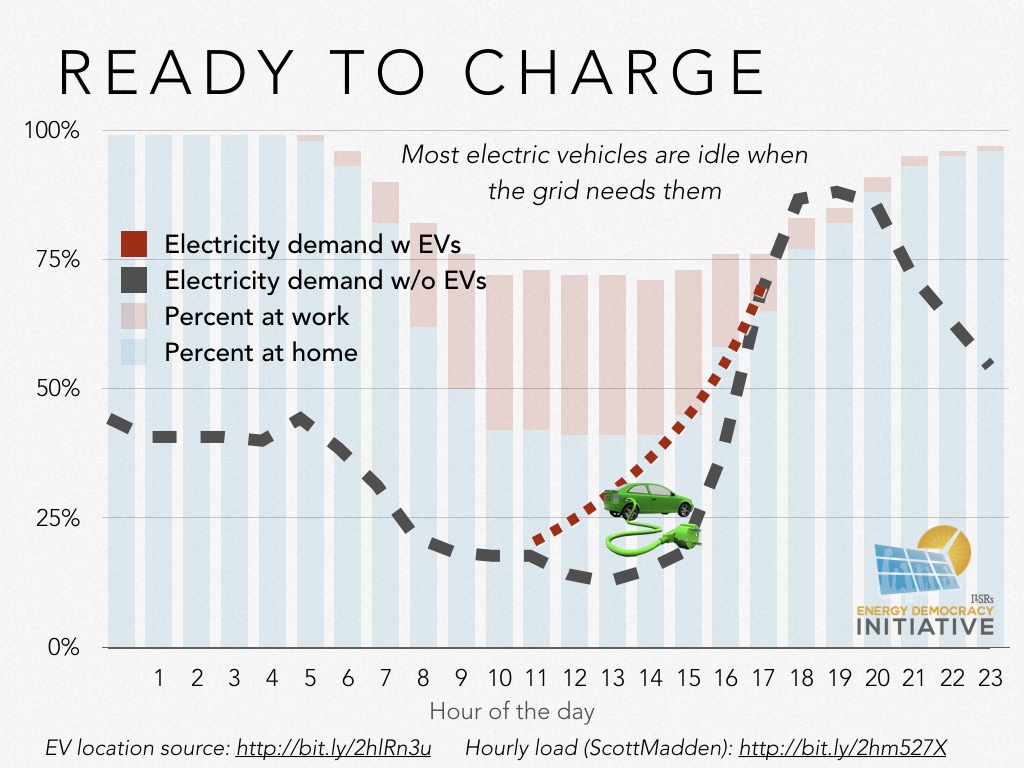
The amount of additional demand needed from electric vehicles to achieve this outcome is well within projected capacity. The 1.5 million electric cars California expects by 2025 would have a maximum energy demand of about 7,000 megawatts, more than double the capacity needed to substantially smooth the current afternoon rise in peak energy demand.
As discussed later, widely distributed charging infrastructure will be key to accessing this resource, as few homes or businesses currently have car chargers. Furthermore, the amount and availability of bill credits or compensation for grid exports (or in the case of Hawaii, a tariff that provides no payment for excess solar production) will strongly impact customer behavior.
Soaking Up Supply
Charging controls or pricing incentives can also motivate electric vehicle drivers to charge overnight, or whenever clean energy production is strongest.
In markets like the Midwest that have abundant wind power, clean energy production often peaks overnight when demand is lowest. The chart below shows the daily demand curve for the Midwest Independent System Operator, which serves a number of states in the Midwest. The 50,000 megawatt-hour gap between daytime and nighttime demand (in July, when the grid is built to accommodate daytime load boosted by air conditioning) could accommodate over 7.5 million electric vehicles on Level 2 (240-volt) chargers without building a single new power plant. That’s almost 2 million more cars than the total number registered in the entire state of Illinois.
|
Zo genoeg geplakt... 
Maar nu ga jij nog zeggen dat men iets vergeten is... 
Laatst gewijzigd door Micele : 18 februari 2018 om 10:48.
|